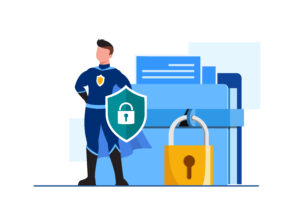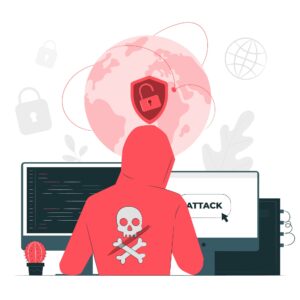
How can you identify and assess potential risks? Let’s talk about cybersecurity for eCommerce businesses.
Every website needs to take care of its security. But when it comes to eCommerce businesses, they need to take their protocols to a whole new level. Whether they are earning a dollar or a million a month, risks related to financial fraud need to be minimized.
While eCommerce grows every year, the number of malicious activities targeted toward these websites grows too. Instead of thinking that the hackers might avoid your website because it’s too small or insignificant, try to do what’s in your power to mitigate any risks.
Thankfully, there are many different ways in which you can ensure the safety of both your business and your customers. Some of the methods can be implemented by investing small amounts, yet they will bring a huge boost to your security.
Importance of Cybersecurity for eCommerce Businesses
What separates eCommerce businesses from other websites is that they are selling physical or digital items to individuals. Naturally, transactions occur between customers and an online store. This is what makes eCommerce businesses attractive to hackers and fraudsters, as they might get their hands on money or products. This is why we need to consider cybersecurity for ecommerce businesses.
The danger that lies here can unwrap in multiple ways, neither of them being positive for both sides. If a hacker gets their hands on a user’s account and makes unsolicited purchases, you will be responsible for refunding them and in some ways, comforting the customer. Sometimes, this process is hard to execute, which can lead to dissatisfied customers.
In other situations, if your business has a security breach, hackers might leak customer data, which again reflects on your reputation. Yahoo had suffered a breach that led to more than 5000 million accounts being leaked.
No matter whether the direct target of the attack is your customers or your business, it will certainly lead to financial losses, blows to your reputation, as well as lowered profit and traffic for some period.
If you mishandled the user data, you might even be fined based on regulatory documents such as CCPA or GDPR. If you get sued, then the previously mentioned consequences will have an even larger impact on your business.
Ways to Mitigate Cyber Threat Risks

There are various ways in which you can mitigate cyber threats. Some of them are quite straightforward, while others might require a more technological approach. In both cases, expect to make an investment in this field.
Keep in mind that every cent you spend on the cybersecurity for your eCommerce company might pay off significantly. Fines related to data breaches and profit loses are significantly larger than the amount you have to invest in cybersecurity to be almost completely safe.
Risk mitigation software
We’ve all noticed the rise of artificial intelligence in various spheres. Some people preach that AI will take our jobs, while others laugh at the wrong mathematical equations that ChatGPT delivers. While both extremes might make sense in some cases, it’s certain that AI brought innovation in various fields.
In terms of risk mitigation, we’ve seen a lot of companies start to find innovative ways to use AI for cybersecurity. You can seek out the top financial risk management software to see the various features that these programs have.
AI can analyze vast amounts of data much quicker than humans, allowing us to make better and faster decisions. In terms of fraud avoidance, risk management software can scan millions of fraudulent transactions, and help and then help you with troublesome activities on your website.
You can also decide to use traditional antivirus software. This type of software has been always popular, and although it can’t be as versatile as modern risk management software, it can surely protect employee devices.
Assessing vulnerabilities
While risk mitigation software can help you defend yourself from real-time fraudulent activities, it’s important to make routine checks on your own. Assessing vulnerabilities of your eCommerce businesses is a process that helps you make cybersecurity-related decisions with the aim of increasing your security.
For this process, it’s good to hire an expert who will do a full cybersecurity audit. In case you’re a cybersecurity expert, I apologize and I believe that you can do this on your own.
Depending on the size of your business, you need to consider both internal and external factors for this process. Sometimes a human error can lead to a security breach, while sometimes is outdated software.
Utilizing hardware-related measures
If you’re managing your eCommerce business from a physical location, there are certain measures that you need to implement. For example, while allowing employees to bring their own devices to work, you don’t know whether they are completely safe from malware.
By having company-wide safety measures at your business, the chances of data breaches can be lowered. Sometimes, this can mean biometric or 2FA methods, but you should also complement your protocols with a firewall and antivirus for your devices.
Routers and switches at your company also need to be configured in ways that ensure security. You should check their software, and also change any default passwords that they came with, as this can be a significant weak point.
Data backup
In a worst-case scenario, you should be able to prevent any data from being lost. Regular data backups can be life-saving for both personal and professional uses. In terms of user data and businesses, you are obliged to do what’s in your power to ensure the safety of your data storage.
If a malicious attack happens, or an accident or terrible weather conditions harm your data storage, it’s important to quickly restore any lost data. One way of achieving this is by having a backup on a cloud-based service.
There are various options, that help you to store terabytes of data for a monthly or yearly fee. The cost of cloud storage is insignificant compared to the headache you will get if the data of your employees and customers gets lost or deleted.
Common Threats for eCommerce Businesses

While hackers are becoming smarter and smarter as time progresses, they are still hanging to a couple of the most effective methods. Of course, there are various different types of cyber threats, but I will cover those that are more likely to occur.
Financial fraud
An obvious risk for eCommerce businesses is suffering from financial fraud. This usually occurs if hackers get their hands on customers’ accounts which they use for making purchases that weren’t approved by them.
Regardless of how the hackers got customer’s credentials, significant problems might occur. If you happen to have a low amount of transactions, you can choose to manually approve transactions once you recognize them as legitimate.
Fraudulent transactions often order or make purchases at addresses that aren’t similar to the previous transactions of the customer. Another way to conduct financial fraud is through chargebacks. Through this method, fraudsters claim that they haven’t received the ordered goods or products and ask for a refund.
Malware
For both individuals browsing the internet and business owners, getting malware on your computer can be a serious problem. The more valuable data you have on your computer, the larger the damage might be.
Malware refers to programs that once installed, harm your computer and data in various ways. Popular malware types are:
- Spyware
- Viruses
- Trojan horses
- Ransomware
Spyware can be quite dangerous for business owners as it can track their everyday processes, and steal various information. This type of malware can be used to harm the future ventures of a certain business and steal ideas or employee data.
Ransomware is another dangerous type of malware. What malware does is that it takes your computer, or computer network, hostage and threatens you to make a certain payment to retrieve your data. While it can also destroy your data, this is where data backup comes in handy.
Phishing
Of course, another common way of getting to someone’s data is through phishing. This method of hacking is the process of creating a website that’s identical to another but with a slight change in the domain name.
You usually get to these websites by receiving an email from an unknown sender. Once you leave data on this website, you can expect that the hackers will misuse it however they like. You can spot phishing websites by their lack of SSL protocol.
eCommerce Businesses Need to Assess and Remove Risks on Time
Regardless of whether you’re selling plastic bracelets or computer parts, the safety of your business and customers needs to be your top priority. Investing in cybersecurity for your ecommerce business doesn’t have an obvious return on investment, but failing to protect your business and data can lead to significant financial and reputational losses.
Many businesses end up bankrupt after suffering data breaches even though it was preventable with the right steps. Keep in mind that cybersecurity for ecommerce isn’t a one-time task that can be checked off. Instead, cybersecurity is an aspect of online business that needs to be periodically assessed and updated.
Hopefully, by understanding the common threats that online store owners might experience, as well as the most efficient ways of mitigating them, you won’t have any troubles.
What Is EcomBalance?

EcomBalance is a monthly bookkeeping service specialized for eCommerce companies selling on Amazon, Shopify, Ebay, Etsy, WooCommerce, & other eCommerce channels.
We take monthly bookkeeping off your plate and deliver you your financial statements by the 15th or 20th of each month.
You’ll have your Profit and Loss Statement, Balance Sheet, and Cash Flow Statement ready for analysis each month so you and your business partners can make better business decisions.
Interested in learning more? Schedule a call with our CEO, Nathan Hirsch.
And here’s some free resources:
- Monthly Finance Meeting Agenda
- 9 Steps to Master Your Ecommerce Bookkeeping Checklist
- The Ultimate Guide on Finding an Ecommerce Virtual Bookkeeping Service
- What Is a Profit and Loss Statement?
- How to Read & Interpret a Cash Flow Statement
- How to Read a Balance Sheet & Truly Understand It









